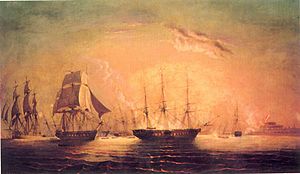First siege of Callao facts for kids
Quick facts for kids First siege of Callao |
|||||||
|---|---|---|---|---|---|---|---|
| Part of the Peruvian War of Independence | |||||||
 Cochrane's fleet blockades Callao by sea |
|||||||
|
|||||||
| Belligerents | |||||||
| Commanders and leaders | |||||||
| Strength | |||||||
| 7,000 men 8 warships |
2,000 soldiers and militiamen 3 warships Several armed merchant ships |
||||||
| Casualties and losses | |||||||
| Unknown | 400 casualties | ||||||
The first siege of Callao was an important event in the Peruvian War of Independence. A siege happens when an army surrounds a place to cut off its supplies and force it to surrender. In this case, the Liberating Expedition of Peru, led by General José de San Martín, surrounded the Real Felipe Fortress and other forts in Callao.
This siege lasted from July to September 1821. It ended when Marshal José de La Mar, who was defending the forts for Spain, decided to switch sides and join the independence fighters, also known as the Patriots. This was a big win for the Patriots.
Contents
Why the Siege Happened
On July 12, 1821, the Spanish viceroy, José de la Serna, and his army left Lima and moved into the mountains. The next day, General San Martín's army entered Lima.
With Lima secured, San Martín's army began to surround Callao by land. At the same time, the Chilean fleet, led by Admiral Thomas Cochrane, was already blocking Callao from the sea. This double blockade meant the city was completely cut off.
The Spanish forces defending Callao had about 2,000 soldiers and local fighters. Their leader was Marshal José de La Mar. On July 13, General San Martín sent a message to La Mar, asking him to surrender. But La Mar refused.
The Siege Begins
During the siege, there were often small fights. Patriot soldiers and ships would attack the Spanish defenders. On July 24, a Patriot messenger went into the fort. He tried to convince the Spanish soldiers to join the independence cause. This attempt was not successful.
That same night, Admiral Cochrane's fleet attacked the port. They burned two small Spanish ships and captured three others. The fighting continued.
Bombing the Forts
From August 4, the Patriot army started bombing the forts with large cannons called howitzers. They did this every night until August 14. The goal was to make the Spanish soldiers tired and lose hope.
On August 14, General Juan Gregorio de las Heras led a brave attack on the fort by land. His plan was for 150 horsemen and 1,000 foot soldiers to rush from their barracks. They hoped to get through the fort gates before they could be closed.
The attack did not fully succeed in taking the fort. However, the Patriot cavalry managed to kill or capture many Spanish soldiers who were outside the fort. In this fight, the Patriots had 27 soldiers hurt or killed, while the Spanish had 41. A Spanish officer named Colonel Mariano Ricafort was wounded and captured.
Spanish Army Tries to Help
Meanwhile, the Spanish Viceroy La Serna, who was in Cuzco, planned to send help to Callao. General José de Canterac led this rescue mission. He had 3,100 soldiers and 9 cannons. They left Jauja at the end of August.
Canterac's journey was very difficult. They had to cross the high Andes mountains. They also faced attacks from local fighters called montoneros. On September 8, Canterac's troops reached the area outside Lima. The Patriot army was waiting in strong defensive positions.
General San Martín had more soldiers than Canterac. But he decided not to attack, even though General Las Heras wanted him to. This allowed Canterac to march on and enter Callao.
San Martín believed that the Spanish in Callao were already in a bad situation. He said in a letter:
They are lost. Callao is ours. They do not have provisions for fifteen days. The auxiliaries of the mountains are going to eat them. Within 8 days they will have to surrender or meet the end of our bayonets.
After a meeting in Callao, Canterac decided to return to the mountains. His soldiers were excited at first, thinking they were going to fight. But when they realized they had to cross the mountains again, they became very sad and many soldiers left the army.
Even though Canterac's troops had some success against San Martín's soldiers who chased them, their army was much smaller and had fewer supplies when they returned to Jauja.
The Siege Ends
When Canterac's army left the forts, the Spanish soldiers in Callao were alone again. They only had enough food for four more days. It became clear that no more help or supplies would reach them.
Seeing this, San Martín offered Marshal La Mar a chance to surrender honorably. He told La Mar that Canterac's army was leaving in a terrible state. Faced with this, La Mar held a meeting with his officers. They all agreed that surrendering was their only choice.
The surrender terms were fair. The Spanish soldiers were allowed to leave with their uniforms and light weapons. They marched out with their flags flying, and the Patriot army honored them with a cannon salute. After leaving their rifles, the regular soldiers could join the main Spanish army in Arequipa. The local fighters could go back to their homes. About 600 soldiers and 1,000 local fighters surrendered.
San Martín's kind terms were criticized by some people. However, they helped the Patriot cause. Many Spanish officers and soldiers decided to join the independence army. They were given the same rank they had before. Marshal La Mar himself was one of them. He gave up his old titles from Spain and Peru. He then served the cause of independence faithfully, even becoming president of Peru later on.
See also
 In Spanish: Primer sitio del Callao para niños
In Spanish: Primer sitio del Callao para niños

